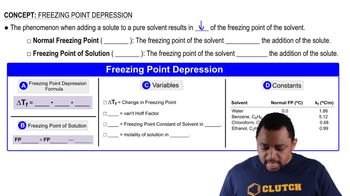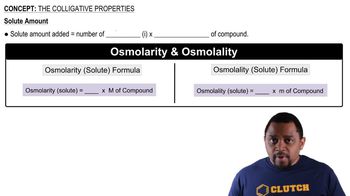Calculate the freezing point and boiling point of each aqueous solution, assuming complete dissociation of the solute. a. 0.100 m K2S b. 21.5 g of CuCl2 in 4.50⨉102 g water
Ch.14 - Solutions
Chapter 14, Problem 95
What mass of salt (NaCl) should you add to 1.00 L of water in an ice cream maker to make a solution that freezes at -10.0 °C? Assume complete dissociation of the NaCl and density of 1.00 g/mL for water.
 Verified step by step guidance
Verified step by step guidance1
Identify the formula for freezing point depression: \( \Delta T_f = i \cdot K_f \cdot m \), where \( \Delta T_f \) is the change in freezing point, \( i \) is the van't Hoff factor, \( K_f \) is the cryoscopic constant, and \( m \) is the molality.
Determine the change in freezing point: \( \Delta T_f = 0.0 \text{ °C} - (-10.0 \text{ °C}) = 10.0 \text{ °C} \).
For NaCl, the van't Hoff factor \( i \) is 2 because it dissociates into two ions: Na\(^+\) and Cl\(^-\).
Use the known value of \( K_f \) for water, which is 1.86 \text{ °C kg/mol}. Substitute the values into the formula: \( 10.0 = 2 \cdot 1.86 \cdot m \) to solve for molality \( m \).
Convert molality to mass: Use the definition of molality \( m = \frac{\text{moles of solute}}{\text{kg of solvent}} \) and the molar mass of NaCl (58.44 g/mol) to find the mass of NaCl needed.

Verified video answer for a similar problem:
This video solution was recommended by our tutors as helpful for the problem above.
Was this helpful?
Key Concepts
Here are the essential concepts you must grasp in order to answer the question correctly.
Freezing Point Depression
Freezing point depression is a colligative property that describes how the freezing point of a solvent decreases when a solute is added. The extent of this depression depends on the number of solute particles in the solution, not their identity. For ionic compounds like NaCl, which dissociates into two ions (Na+ and Cl-), the effect is doubled, making it crucial for calculating the required mass of solute to achieve a desired freezing point.
Recommended video:
Guided course

Freezing Point Depression
Colligative Properties
Colligative properties are properties of solutions that depend on the ratio of solute particles to solvent molecules, rather than the type of solute. These properties include boiling point elevation, freezing point depression, vapor pressure lowering, and osmotic pressure. Understanding these properties is essential for determining how much solute to add to achieve specific physical changes in the solvent, such as lowering the freezing point of water.
Recommended video:
Guided course

Colligative Properties
Molarity and Density
Molarity is a measure of concentration defined as the number of moles of solute per liter of solution. In this context, knowing the density of water (1.00 g/mL) allows for the conversion between volume and mass, which is necessary for calculating how much NaCl to add. Since the problem involves a specific volume of water, understanding how to relate mass, volume, and molarity is key to solving the question.
Recommended video:
Guided course

Molarity
Related Practice
Textbook Question
Textbook Question
Calculate the freezing point and boiling point of each aqueous solution, assuming complete dissociation of the solute. c. 5.5% NaNO3 by mass (in water)
1
views
Textbook Question
Use the van't Hoff factors in Table 13.9 to calculate each colligative property: a. the melting point of a 0.100 m iron(III) chloride solution
Textbook Question
A 1.2 m aqueous solution of an ionic compound with the formula MX2 has a boiling point of 101.4 °C. Calculate the van't Hoff factor (i) for MX2 at this concentration.
Textbook Question
A 0.100 M ionic solution has an osmotic pressure of 8.3 atm at 25 °C. Calculate the van't Hoff factor (i) for this solution.
